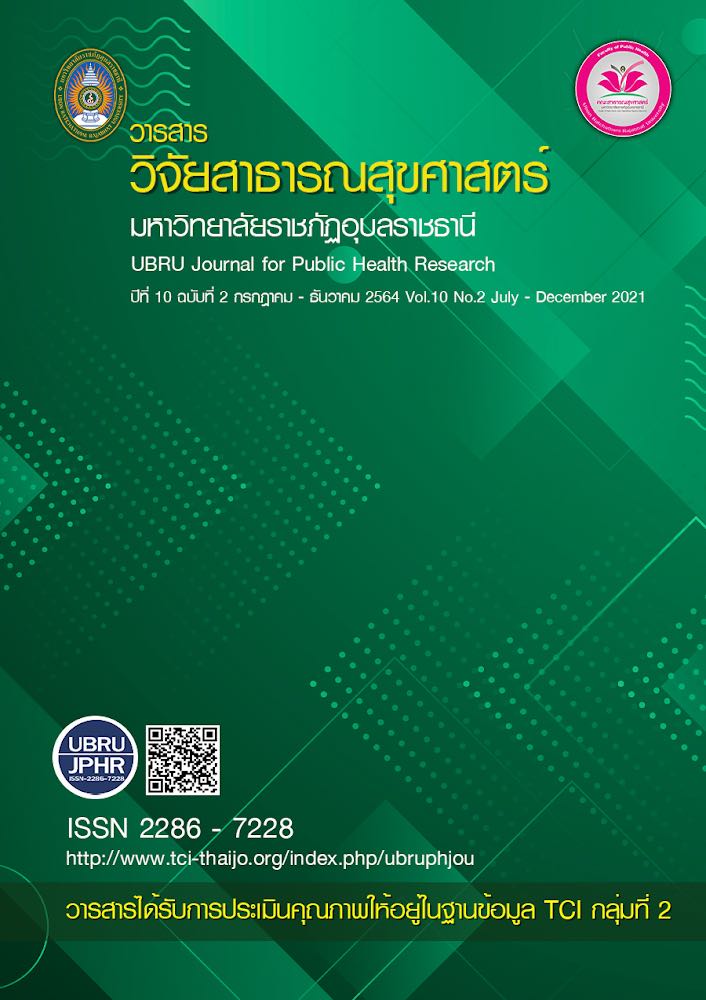A survey of solid waste composition from three types of Buddhist Temples
Keywords:
Survey, solid waste guidelines, temples, solid waste compositionAbstract
This research aimed to conduct a survey of investigating waste generation rate, bulk density and solid waste composition in three types of Buddhist temples, in order to propose an appropriate solid waste management guideline for monasteries. Three types of temples in Khon Kaen Province had been selected from different areas. These included the royal monastery (Sri Chan temple), private monastery (Ming Pho Wanaram temple) and house of priests (Pa Rattanaram temple), respectively. Data including unit waste generation rate, bulk density and solid waste composition were collected for seven days consecutively in a month for analyzed three times and the same data collection process were conducted repeatedly for three months in total from three temples. These data collections were analyzed and solid waste management guidelines were proposed.
It was found that Sri Chan temple showed the highest average rate of generated solid waste (valued 0.011 kg/m2-day) followed by Ming Pho Wanaram temple (valued 0.004 kg/m2-day) and Pha Rattanaram temple (valued 0.001 kg/m2-day), respectively. The highest average bulk density of 0.125 kg/L was found at Sri Chan temple followed by Ming Pho Wanaram temple and Pa Rattanaram temple with the value of 0.087 and 0.080 kg/L, respectively. Sri Chan temple had the maximum proportion of generated solid waste compositions including food wastes, vegetable wastes and fruit wastes. These findings shown were more than those found from Ming Pho Wanaram temple and Pa Rattanaram temple. These results also caused Sri Chan temple having the highest bulk density of solid waste. The solid waste composition of three types Buddhist temples showed the highest garbage (food waste, vegetable waste and fruit waste) of solid waste. Sri Chan temple having the highest garbage of solid waste composition accounted for 40.56%. This figure was followed by 30.61% from Pa Rattanaram temple and by 19.84% from Ming Pho Wanaram temple, respectively. Based on the results of this study, the recommendations of solid waste management were proposed. Wastes should be classified into four groups including degradable wastes, recycled waste, hazardous wastes and general wastes. These different types of wastes should have its own garbage bin colored differently including green, yellow, orange and blue, respectively. The measures of solid waste management should have three important steps including reducing sources of wastes from its original places, from middle sources of waste process and from its final destination.
References
กรมควบคุมมลพิษ. (2547). การจัดการขยะมูลฝอยชุมชนอย่างครบวงจร. กรุงเทพมหานคร : โรงพิมพ์คุรุสภาลาดพร้าว.
กรมควบคุมมลพิษ. (2562). สรุปสถานการณ์มลพิษ ของประเทศไทย ปี 2561. กรุงเทพมหานคร : หจก.ส.มงคลการพิมพ์.
กรมส่งเสริมคุณภาพสิ่งแวดล้อม. (2561). จัดหนักหลัก 7R: วิธีลดขยะที่ทำให้โลกน่าอยู่ขึ้น [ออนไลน์]. ค้นเมื่อวันที่ 1 มีนาคม 2563, จาก scpdatacenter.deqp.go.th/newsdetail.php?id=468.
กองนโยบายและแผนงาน. (2561). การศึกษาการกระจายตัวของวัด ในเขตกรุงเทพมหานคร ปี พ.ศ.2560. กรุงเทพมหานคร : สำนักผังเมือง.
กิตติ ชยางคกุล. (2553). ผลกระทบด้านสุขภาพและสิ่งแวดล้อมจากการจัดการขยะมูลฝอย: ศึกษากรณีการจัดการขยะ มูลฝอยขององค์การบริหารส่วนตำบลคลองสาม อำเภอคลองหลวง จังหวัดปทุมธาน. วารสารวิชาการมหาวิทยาลัยอีสเทิร์นเอเชีย. 2 (1), 154-165.
ประกายรุ้ง ศรีนวลปาน, วนิดา ชูอักษร. (2562). การศึกษาปริมาณ ลักษณะของขยะ และความรู้ความเข้าใจในการจัดการขยะของนักท่องเที่ยว กรณีศึกษา ตลาดริมน้ำวัดศาลเจ้า จังหวัดปทุมธานี. วารสารการแพทย์และสาธารณสุข มหาวิทยาลัยอุบลราชธานี. 2(3), 148-155.
พีรยา วัชโรทัย, จำลอง โพธิ์บุญ. (2557). การจัดการขยะขององค์กรปกครองส่วนท้องถิ่น: กรณีศึกษา เทศบาลตำบลเมืองแกลง จังหวัดระยอง. วารสารการจัดการสิ่งแวดล้อม. 10(2), 71–89.
วิชชากร จารุศิริ. (2555). การจัดการขยะเป็นแหล่งพลังงานด้วยการแปรรูปขยะพลาสติกเป็นน้ำมันเชื้อเพลิง. วารสารมหาวิทยาลัยศรีนครินทรวิโรส สาขาวิทยาศาสตร์และเทคโนโลยี. 4(7), 125–144.
วรพจน์ รัตนพันธุ์, กมลวรรณ โพธิ์แก้ว, นุชนาฏ นิลออ. (2552). การศึกษาปริมาณและองค์ประกอบของขยะในพื้นที่เกาะมุกด์ จังหวัดตรัง. วารสารวิจัยมหาวิทยาลัยเทคโนโลยีราชมงคลศรีวิชัย. 1(2), 46-53.
ศูนย์ความเป็นเลิศทางด้านชีวมวล. (2559). การเพิ่มศักยภาพการจัดการขยะในพื้นที่เกาะท่องเที่ยวอย่างยั่งยืน. นครราชสีมา.
สำนักงานสถิติจังหวัดขอนแก่น. (2559). สถานการณ์ขยะจังหวัดขอนแก่น ปี 2559 [ออนไลน์]. ค้นเมื่อวันที่ 1 มีนาคม 2563, จาก http://khonkaen.nso.go.th/images/2560/conclusion/kkgarbage2560.pdf.
สำนักวิชาการ สำนักงานเลขาธิการสภาผู้แทนราษฎร. (2562). การจัดการขยะมูลฝอยในประเทศไทย. กรุงเทพฯ: สำนักงานเลขาธิการสภาผู้แทนราษฎร.
สำนักอนามัยสิ่งแวดล้อม กรมอนามัย กระทรวงสาธารณสุข. (2552). คู่มือ วัดสะอาด ฆารวาสสุขใจ. กรุงเทพมหานคร : สำนักงานกิจการโรงพิมพ์องค์การสงเคราะห์ทหารผ่านศึก.
อนันต์ชัย เขื่อนธรรม. (2549). วิธีการทางสถิติและการวิเคราะห์ข้อมูล. กรุงเทพมหานคร: สำนักพิมพ์มหาวิทยาลัยเกษตรศาสตร์.
อิทธิพล โฉมสุภาพ, วีณา อิศรางกูร ณ อยุธยา, กุหลาบ ปุริสาร. (2561). รูปแบบการจัดการขยะมูลฝอยโดยการมีส่วนร่วมของชุมชนบ้านดงสะคร่าน ตำบลวังสวาบ อำเภอภูผาม่าน จังหวัดขอนแก่น. วารสารวิทยาลัยบัณฑิตเอเซีย. 8(ฉบับพิเศษ), 308–322.
Chiemchaisri, C., Juanga, J.P., and Visvanathan, C. (2007). Municipal solid waste management in Thailand and disposal emission inventory. Environ. Monit. Assess. 135: 13-20.
Downloads
Published
How to Cite
Issue
Section
License
เนื้อหาและข้อมูลในบทความที่ลงตีพิมพ์ในวารสารวารสารวิจัยสาธารณสุขศาสตร์ มหาวิทยาลัยราชภัฏอุบลราชธานี ถือเป็นข้อคิดเห็นและความรับผิดชอบของผู้เขียนบทความโดยตรงซึ่งกองบรรณาธิการวารสาร ไม่จำเป็นต้องเห็นด้วย หรือร่วมรับผิดชอบใดๆ
บทความ ข้อมูล เนื้อหา รูปภาพ ฯลฯ ที่ได้รับการตีพิมพ์ในวารสารนี้ ถือเป็นลิขสิทธิ์ของวารสารฯ หากบุคคลหรือหน่วยงานใดต้องการนำทั้งหมดหรือส่วนหนึ่งส่วนใดไปเผยแพร่ต่อหรือเพื่อกระทำการใดๆ จะต้องได้รับอนุญาตเป็นลายลักอักษรณ์จากบรรณาธิการวารสารนี้ก่อนเท่านั้น


